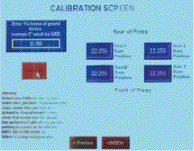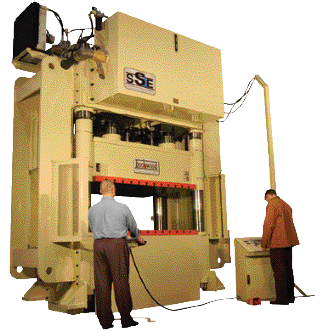Fully outfitted control-wise, the press allows Taylor Press Products to protect its tool investments—it runs more than 50 jobs on the new press, most using progressive tooling along with some blanking dies—with state-of-the-art die protection.
“I wanted to get the latest press-control technology, with part-storage capability and more, in an online PLC setup,” says Taylor, further explaining that energy usage, given the high power rates in the region, was another major factor in press selection.
“I was very concerned about energy efficiency,” he says. “We went with a low-frequency drive motor (150 hp variable-frequency) on this press to cut our energy costs, as constantly turning a traditional motor can be very expensive. The low-frequency drive costs more up front but there is a payback down the road.”
The model’s heavy-duty design and robust tie-rod construction also caught Hugh Taylor’s eye, seeing as the press would be tackling tough material all day long in a heavy-truck market known for extremely short lead times—making press reliability of paramount importance.
“We perform short to medium runs, and though press speeds are als important because they determine piece price, we have to deal with high-strength steel (80,000 ksi min. yield) typically 3⁄8 in. thick, so we are paying for the material, not for the press going up and down,” Taylor explains.
That said, speed is not sacrificed, as the 1000-ton hydraulic press runs at 600 strokes/hr. given a 6-in. shut height.
“The biggest concern,” he says, “is making sure we can get the parts and scrap out of the press. By that time the material is fed and ready to go and we are making our next hit.”
Nourishing the hungry press is a servo feed from Dallas Industries, Troy, MI, capable of feeding 3⁄8-in.-thick high-strength steel at Taylor Press Products in coil widths to 12 in.—24 in. when feeding mild steel.
Tames Snapthrough
The robust press line has proven its mettle on a variety of jobs, with Taylor recalling one particular part that brought teeth-jarring snapthrough on previous lines.
 |
| The four-corner active-leveling control system allows Taylor to blank advanced high-strength steels with minimal breakthrough shock. |
Taylor’s requirements presented a few challenging design issues for the press manufacturer.
“Off-center loading was present within many of Taylor’s dies,” recalls Darrell Harrelson, lead application and sales engineer at Beckwood. “Additionally, many of its smaller dies could be improperly located within the large press bed to create additional off-center-loading problems.”
Taylor’s application called for blanking of advanced high-strength steels, causing tremendous breakthrough shock and reverse tonnage, especially without nitrogen shocks incorporated into the dies.
Beckwood recommended its four-corner active-leveling control system to counteract these effects. In addition to maintaining parallelism, the controller can sense the acceleration of the breakthrough shock, and adjust the proportional valves to ‘catch’ the ram, greatly reducing the effects of the breakthrough in challenging applications such as Taylor’s, according to Beckwood officials.
The control system utilizes a servo proportional valve and high-resolution linear transducers on each of the four main cylinders. A 32-bit motion controller, with less than 1 msec control-loop time, monitors the four corners of the press independently, and uses the proportional hydraulic valves to maintain bed-to-ram parallelism throughout the pressing portion of the cycle.
“Maintaining the parallelism protects the tooling and helps ensure consistent part quality on every hit,” Harrelson says, noting that maintaining parallelism through the downstroke and adjusting for breakthrough shock are just two of the control’s features. It also can benefit dies with nitrogen springs by utilizing programmable distance on the upstroke. Reportedly, this feature smoothly decompresses unbalanced nitrogen during the upstroke, maintaining bed-to-ram parallelism. Once the tooling is clear of the nitrogen, it can be placed safely into a traditional fast-retract mode. MF
View Glossary of Metalforming Terms
See also: Beckwood Press Company
Technologies: Stamping Presses








